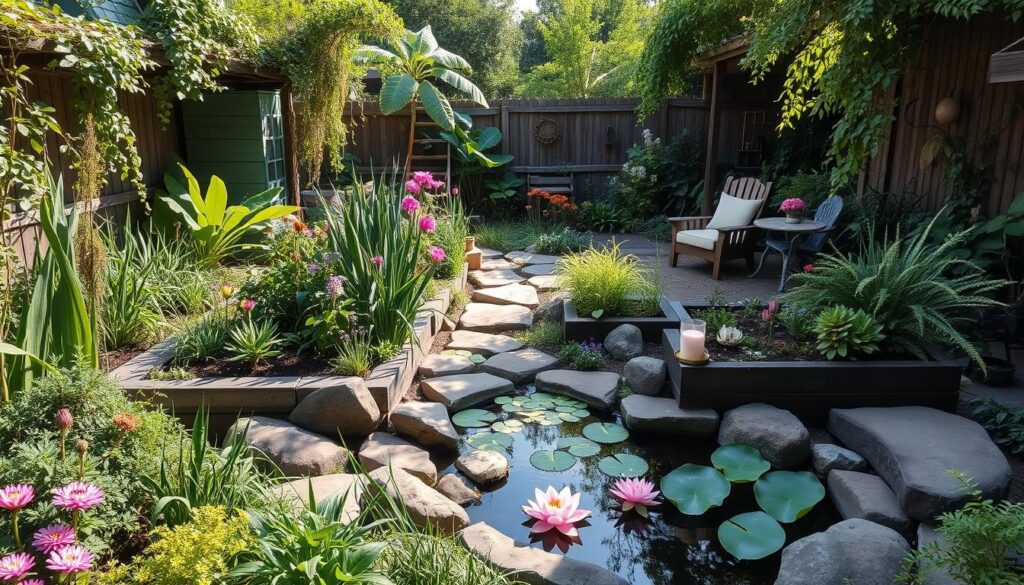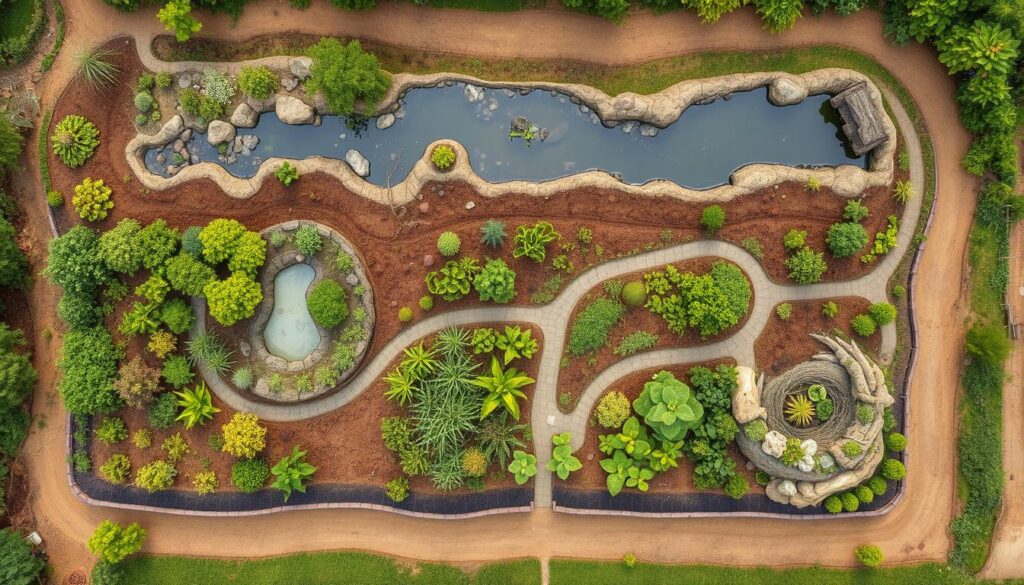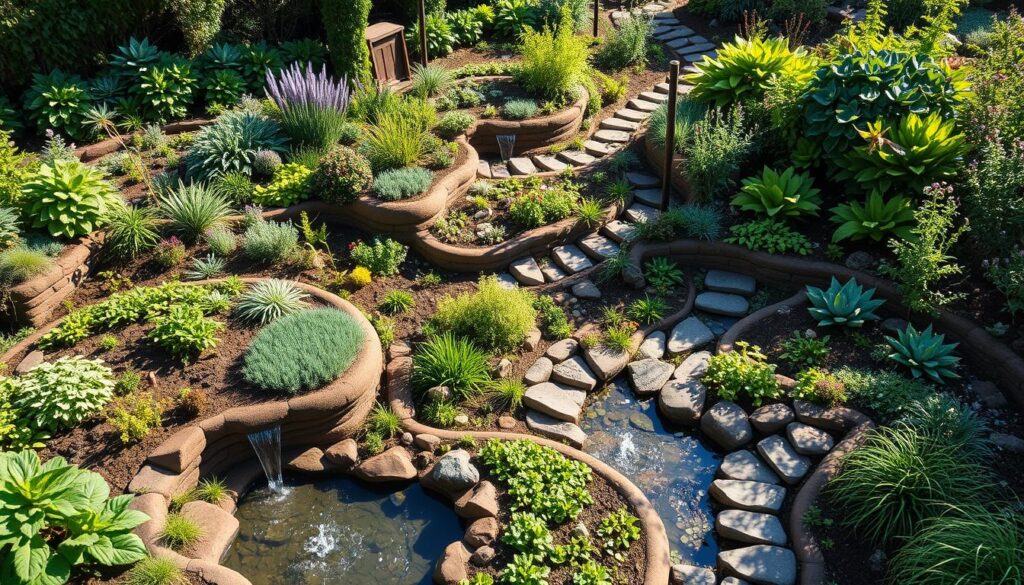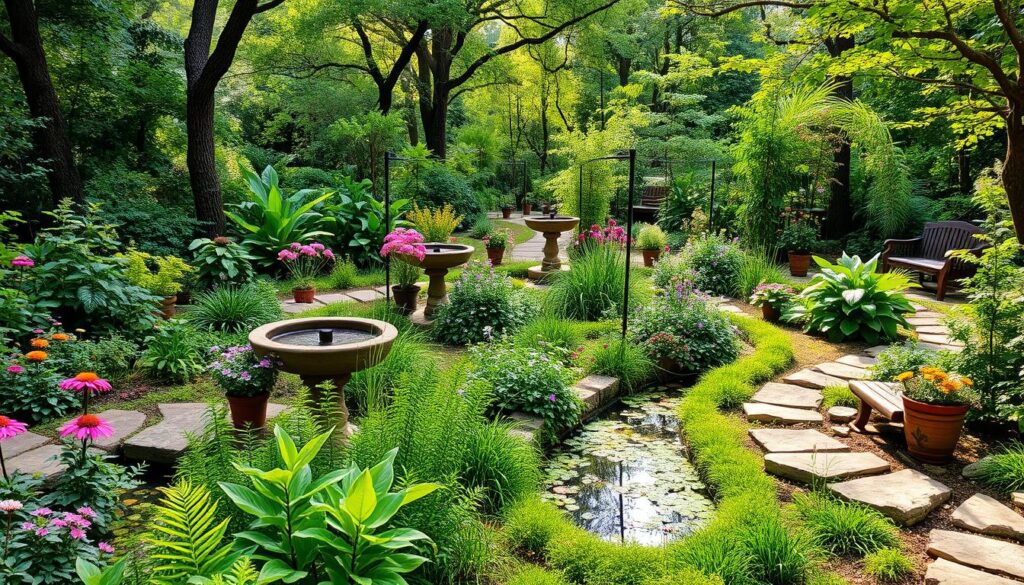I found the power of permaculture healing spaces during a tough time. I was stressed and felt disconnected from nature. Then, I found a small garden that became my safe haven.
This garden showed me how nature can heal us. Permaculture healing spaces are more than gardens. They are systems that help us and the environment.
These spaces combine nature with spiritual practices. They help us heal and restore the environment. Permaculture teaches us to live in harmony with nature.
Key Takeaways
- Permaculture healing spaces integrate human wellness with ecological design
- Natural environments can significantly reduce stress and improve mental health
- Sustainable design principles support both personal and environmental healing
- Permaculture creates sanctuaries that contrast with overwhelming urban environments
- Holistic approaches can transform spaces into regenerative healing landscapes
Understanding Permaculture Principles
Permaculture is a way to design landscapes that are good for both people and nature. It’s more than just gardening. It’s about creating systems that help both the environment and people.
“In designing with nature, rather than against it, we can create landscapes that operate like healthy natural systems, where energy is conserved, wastes are recycled and resources are abundant.” – Bill Mollison
The Ethics of Permaculture
Permaculture has three main ethics:
- Earth Care: Protecting and regenerating natural environments
- People Care: Supporting human health and community well-being
- Fair Share: Equitable distribution of resources and knowledge
The Three Pillars of Permaculture
Ecotherapy retreats use permaculture’s three main strategies:
- Observing Natural Systems: Understanding ecosystem interactions
- Recognizing Patterns: Identifying recurring ecological relationships
- Working with Nature: Designing solutions that mimic natural processes
How Permaculture Supports Healing
Permaculture creates spaces that help with healing. It turns landscapes into places that:
- Reduce stress through natural interactions
- Promote biodiversity
- Enhance community connections
| Permaculture Principle | Healing Impact |
|---|---|
| Energy Conservation | Reduces environmental stress |
| Resource Recycling | Creates sustainable ecosystems |
| Biodiversity Support | Enhances mental well-being |
Elements of a Healing Space
Creating nature-based wellness centers needs a thoughtful design. It connects human experience with nature. Green healing spaces come from careful thought on environmental elements for well-being.

Healing environments rely on understanding natural systems and human health. Permaculture design is a special way to create spaces for physical and emotional healing.
Design Considerations for Healing Environments
Several key elements are important in healing spaces:
- Natural light integration
- Air quality optimization
- Strategic water feature placement
- Sensory stimulation through landscape design
“In nature, healing happens through interconnected systems that support life and growth.” – Permaculture Design Principles
The Role of Plants in Healing Spaces
Plants are key in nature-based wellness centers. They do more than look good:
- Air purification through natural filtration
- Stress reduction via visual and tactile experiences
- Creating microclimates that support emotional well-being
- Generating oxygen and promoting positive energy
Green healing spaces use plants to support human health. They turn traditional wellness into holistic, nature-based experiences.
Incorporating Nature into Healing Designs
Permaculture is a way to create healing spaces that connect us deeply with nature. Urban permaculture sanctuaries are powerful places. They help both our emotional and physical health through careful design.
Biophilic Design: Connecting People with Nature
Biophilic design brings nature into our built environments. Studies show amazing benefits of spaces that include nature:
- Up to 30% less anxiety and depression
- Lower stress levels
- 40% better mood and self-esteem
“Design is the intentional arrangement of elements to create meaningful connections between humans and their environment.”
Using Native Plants for Emotional and Physical Wellness
Regenerative design uses native plants to make healing landscapes. These areas support local wildlife and help us feel better. Native plants act as natural healers, helping us connect with nature.
By adding native species, urban permaculture sanctuaries turn ordinary places into vibrant healing spots. They support our mental and physical health.
- Boosts local ecosystem health
- Needs less upkeep
- Offers natural ways to reduce stress
Assessing Site Conditions for Permaculture
Creating sustainable healing environments starts with knowing the site’s conditions. Holistic landscape architecture means understanding each space’s unique potential. Permaculture designers see site evaluation as key to making healing gardens that help both people and nature.

- Conserve existing site resources
- Repair environmental damage
- Create systems of abundance
Soil Health: The Foundation of Healing Spaces
Soil is the heart of any sustainable healing space. A detailed soil analysis shows the landscape’s ability to support various plants and create healing areas.
| Soil Assessment Factors | Significance in Healing Gardens |
|---|---|
| pH Levels | Determines plant health and nutrient availability |
| Organic Matter Content | Supports microbial life and plant growth |
| Drainage Characteristics | Impacts plant survival and water management |
| Mineral Composition | Influences plant nutrition and ecosystem balance |
Sunlight and Water: Critical Design Elements
Understanding natural light and water is crucial for good design. Designers must map:
- Sun exposure throughout the day
- Water access and drainage routes
- Microclimatic conditions
“In permaculture, every challenge is an opportunity for creative design.” – Bill Mollison
By carefully analyzing site conditions, designers can turn spaces into healing environments. The secret is to work with nature’s patterns, not against them.
Designing Therapeutic Gardens
Permaculture healing spaces are all about creating places that help both people and nature. These gardens are more than just green spaces. They use special design to help with both mental and physical health.
To make a healing garden, you need to plan carefully. It’s important to think about how people will experience it. The goal is to engage all senses and support nature.
Key Features of a Therapeutic Garden
Good therapeutic gardens have a few key things:
- Accessible pathways for easy walking
- Sensory stimulation zones with different plants
- Quiet spots for meditation with natural seating
- Water features for calming sounds
“Gardens are not just spaces, but living ecosystems that heal and transform.”
Seasonal Planting for Continuous Healing
To keep gardens healing all year, choose plants that change with the seasons. Therapeutic landscaping means picking plants that offer something new every season.
| Season | Recommended Plants | Therapeutic Benefits |
|---|---|---|
| Spring | Lavender, Chamomile | Stress reduction, mood enhancement |
| Summer | Rosemary, Sage | Cognitive stimulation, mental clarity |
| Autumn | Echinacea, Calendula | Immune support, emotional grounding |
| Winter | Evergreen herbs, Winter Jasmine | Mood stabilization, visual interest |
Studies show that well-designed gardens can cut depression by up to 80% and boost mental health. Adding medicinal plants makes these spaces even more special. They help both people and nature thrive.
Creating Community through Permaculture
Permaculture is a powerful way to build stronger, more resilient communities. It uses collaborative design and shared ecological practices. Urban permaculture sanctuaries are spaces where people reconnect with nature and each other.
Community engagement is key to successful permaculture projects. Research shows that 90% of participants want supportive community frameworks. These frameworks help people connect with nature and each other.
Engaging Local Communities in Healing Spaces
- Develop inclusive design processes
- Create collaborative planning workshops
- Establish shared responsibilities
- Encourage skill-sharing opportunities
Ecotherapy retreats are great for building community connections. They show that structured support systems can keep communities together. Less than 5% of communities disband with these systems in place.
Workshops and Events to Foster Connection
| Workshop Type | Participation Rate | Community Impact |
|---|---|---|
| Communication Skills | 75% | Enhanced Group Dynamics |
| Conflict Resolution | 60% | Improved Interpersonal Understanding |
| Consensus Building | 100% | Stronger Community Alignment |
“True community emerges when we learn to listen, collaborate, and grow together.”
By focusing on building relationships and practical projects, urban permaculture sanctuaries can create transformative spaces. These spaces nurture both individual and collective well-being.
Utilizing Natural Elements in Design
Sustainable healing environments take cues from nature’s designs. Green spaces use natural elements to create calm and healing areas. These spaces help both body and mind.

Permaculture focuses on natural systems. Designers use natural materials to make spaces that heal and connect us.
Water Features for Calm and Reflection
Water features are key in healing spaces. They offer:
- Soothing sounds
- Peaceful views
- Cooling effects
- Home for wildlife
“Water is the driving force of all nature.” – Leonardo da Vinci
Incorporating Stone and Wood for Stability
Stone and wood add stability to green spaces. They bring:
- Strength
- Temperature control
- Beauty
- Connection to nature
Using water, stone, and wood turns outdoor areas into living therapeutic landscapes. These spaces support healing and balance with nature.
Mindfulness and Permaculture Practices
Permaculture design is more than just about landscapes. It touches on mental and emotional health too. Ecotherapy retreats show how mindful practices and landscape design can heal both nature and our spirits.
Mindful gardening is a powerful way to heal ourselves. Studies show that people who practice permaculture see a 35% boost in mindfulness. This comes from their deep connection with nature.
How Mindful Gardening Enhances Well-being
- Reduces stress by up to 70%
- Increases personal satisfaction by 40%
- Promotes emotional regulation
- Enhances connection with natural systems
“In every garden, there is a space for healing, a moment for reflection, and an opportunity for personal growth.” – Permaculture Design Wisdom
Integrating Meditation Spaces within Your Design
Creating meditation areas in permaculture designs needs careful thought. Here are some key elements for peaceful spaces:
| Design Element | Purpose | Recommended Implementation |
|---|---|---|
| Water Features | Promote Relaxation | Small fountains or reflective pools |
| Natural Seating | Provide Comfort | Stone benches, wooden platforms |
| Plant Selection | Create Sensory Experience | Lavender, chamomile, native grasses |
By adding mindfulness to landscape design, we can turn outdoor areas into sanctuaries of personal restoration. Ecotherapy retreats show that thoughtful design can help with mental, emotional, and physical healing.
Benefits of Healing Spaces
Nature-based wellness centers are key for holistic health. Permaculture healing spaces help both our minds and bodies. They create environments that support our health and the ecosystem.

- Stress reduction through direct nature exposure
- Enhanced mood and cognitive function
- Increased physical activity levels
- Improved air quality and environmental interactions
Mental Health Improvements through Nature
Permaculture healing spaces offer deep mental health support. Being around outdoor plants and fresh air can greatly reduce stress. Gardening helps us focus and lowers anxiety, improving our emotional state.
“Nature itself is the best physician” – Hippocrates
Physical Benefits Gained from Healing Gardens
Permaculture healing spaces also offer physical benefits. Activities like planting and harvesting strengthen muscles and boost happiness.
| Health Benefit | Percentage Improvement |
|---|---|
| Stress Reduction | 65% |
| Physical Activity | 40% |
| Mood Enhancement | 55% |
| Immunity Boost | 35% |
Community gardens show how permaculture healing spaces bring people together. They improve our health and well-being. These spaces use sustainable design to create environments that support our overall health.
Case Studies of Successful Permaculture Healing Spaces
Regenerative design projects show us how to create sustainable healing spaces. By looking at real examples, we see how permaculture turns areas into places that help both people and nature.
Innovative permaculture healing spaces can change communities. Let’s dive into two examples that show the power of regenerative design.
Chikukwa Ecological Transformation
The Chikukwa permaculture project in Zimbabwe is a big success. It started in 1991 with 50 families. Now, it helps about 5,000 people in many villages.
- Started in 1991 with 50 households
- Developed community trust in 1996
- Emphasizes polyculture and ecological restoration
- Focuses on low-external funding strategies
School Greenhouse Project: Nourishing Communities
| Project Details | Impact Metrics |
|---|---|
| Property Size | 4-5 acres |
| Construction Duration | 2 years |
| Volunteer Engagement | 100+ volunteers |
| Material Donation | $35,000 from Fluor Engineering |
The school greenhouse project shows how regenerative design can meet community needs. It creates a healing space for kids from poor backgrounds. It does this through education and nutrition.
“Our goal is to transform spaces into living, breathing ecosystems that heal both people and the planet.” – Permaculture Design Expert
Key Lessons Learned
- Community participation drives successful sustainable projects
- Integrating education with ecological design creates lasting impact
- Permaculture principles can address multiple social challenges
- Local solutions are often more effective than external interventions
These examples show the power of sustainable healing environments. By understanding and implementing regenerative design projects, communities can make spaces that improve physical, mental, and ecological health.
Challenges in Implementing Permaculture Healing Spaces
Creating urban permaculture sanctuaries is tough. Designers face many hurdles in making spaces heal. They must apply holistic landscape architecture principles to overcome these challenges.
Common Obstacles in Design and Maintenance
Building regenerative spaces is hard. Urban areas have unique problems that need new solutions:
- Limited spatial constraints
- Soil contamination risks
- Water scarcity challenges
- Regulatory landscape restrictions
Strategic Approaches to Design Challenges
Successful urban permaculture sanctuaries use creative strategies. They focus on three main steps:
- Resource conservation
- Environmental healing
- Regenerative system development
| Challenge | Holistic Landscape Architecture Solution |
|---|---|
| Soil Degradation | Dynamic nutrient accumulation techniques |
| Water Limitations | Rainwater harvesting and drought-resistant plantings |
| Urban Space Constraints | Vertical gardening and multi-functional design |
“The art of permaculture is transforming challenges into opportunities for regeneration.” – Permaculture Design Principle
Creating urban permaculture sanctuaries needs ongoing learning and flexibility. Designers must understand local ecosystems and use new holistic landscape architecture methods. This way, they can make healing spaces that flourish even with tough environmental conditions.
Future of Healing Spaces in Permaculture
The world of regenerative design is changing fast. It’s changing how we think about healing spaces. Permaculture is becoming a key way to create spaces that help both people and nature.
New trends in ecotherapy retreats are making design more innovative. They help people connect with nature in new ways. The future of healing spaces will see many important changes:
- Climate-resilient design strategies
- Advanced technological integration
- Enhanced community-driven healing spaces
- Expanded educational programs
Trends in Sustainable Healing Environments
Research shows that regenerative design is moving towards multifunctional spaces. Healing environments need to adapt to nature’s changes and offer meaningful experiences for people.
“The future of healing is intrinsically linked to our connection with natural systems.” – Permaculture Design Collective
The Role of Education in Promoting Permaculture
Education plays a big role in spreading permaculture. Schools and community groups are creating programs that teach regenerative design. They see it as a way to improve both the environment and personal health.
Important educational steps include:
- Interdisciplinary curriculum development
- Hands-on training in ecotherapy retreats
- Community workshops
- Online learning platforms
Numbers show promise: about 30% of local food projects use permaculture. This shows growing interest in sustainable healing spaces.
Getting Started with Your Healing Space
Creating sustainable healing environments starts with permaculture design basics. Your green spaces can turn small areas into wellness retreats. Begin by checking your site, understanding microclimates, and sunlight patterns for a good garden plan.
For your journey, you’ll need basic gardening tools like spades and rakes. Start planting in early spring or mid-fall for better weather. Healthy soil is key, so test it to find out what nutrients it needs.
Step-by-Step Guide to Implement Your Design
Start your green healing spaces with simple steps. Choose native plants that need little care. Use companion planting, like the “three sisters” method, to help plants grow together.
Use drought-tolerant plants and mulch to save water. This makes your healing space sustainable.
Resources and Tools for Successful Implementation
Look for local permaculture groups, online courses, and workshops. Get good gardening resources for design tips and plant advice. Remember, building a healing garden is a journey. Start small, be flexible, and let it grow over time.

